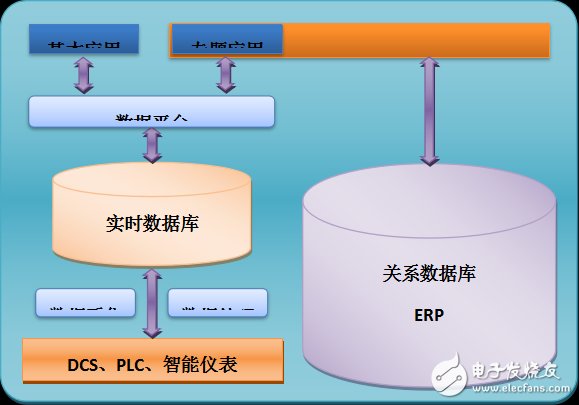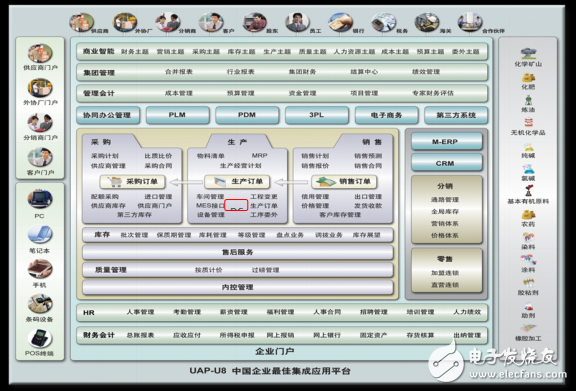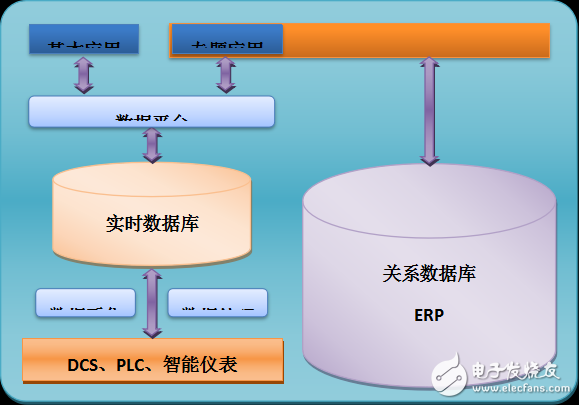**DCS and ERP Integrated Application Solutions**
**Chapter 1: Overview**
In chemical enterprises, production automation control (DCS) and enterprise resource planning (ERP) systems are often isolated from each other. As a result, the information gathered by management through manual methods like reports and phone calls is fragmented, delayed, and incomplete. This makes it difficult for companies to have a full and timely understanding of their overall production status.
The UFIDA DCS and ERP integrated application solution aims to bridge this gap by automatically collecting, filtering, storing, and intelligently analyzing production data via the DCS interface. This data is then integrated into the ERP system, allowing users to access, view, analyze, control, and manage production information through the ERP platform. By leveraging the real-time nature of DCS data, the solution offers various practical application scenarios that enhance operational efficiency and decision-making.

**Chapter 2: Management Requirements for DCS and ERP Integration**
During the production process, computers are primarily used in two areas: production automation control (DCS) and management information systems (ERP), along with office automation (OA). These represent the control layer and the management layer, respectively.
In the process industry, the process control system is a complex, integrated automation system that covers all aspects of the company’s production activities. As an effective tool, DCS (Control Layer) handles essential basic control tasks and real-time data collection and dynamic monitoring within the industrial production process.
Currently, most process-oriented enterprises still face a separation between the control layer and the management layer. To address this, establishing a unified production data platform that connects these layers is essential. This includes interconnecting the management network with the control network, enabling data sharing, collecting and storing real-time DCS data from various devices, and developing advanced applications based on real-time data—common requirements among enterprises.
The DCS and ERP integrated application solution should meet the following functional goals:
- DCS raw data collection and delivery
- Flowchart configuration and browsing
- Trend graph and historical data viewing
- Production data analysis and statistics
- Customized production reports
- Customizable production anomaly alarms
- Data exchange and integration with ERP
- Data grouping according to user needs
- Multi-level user permissions
- Data backup and recovery
- Unidirectional data communication
- Real-time data server with millisecond response
- Multi-user concurrent support
- Scalable database points and collection devices
- System event logging
- System security
- Fault recovery capabilities
**Chapter 3: Solutions**
**3.1 Overall Solution**

**3.1.1 Solution Architecture**
The UFIDA DCS and ERP integrated application solution automatically collects, filters, stores, and analyzes production data through the DCS interface. It integrates this data into the ERP system, enabling users to collect, store, view, analyze, control, and manage enterprise production information. By leveraging the real-time characteristics of DCS data, the solution supports multiple practical application models.
- A management system based on data acquisition, secondary applications, and ERP integration
- Real-time monitoring of the production process, historical traceability, report generation, and operational guidance
- Combining manual data such as inspections and production records to generate comprehensive and accurate production data
- Implementation of specialized applications for production, equipment, quality, and performance evaluation

**Data Acquisition**
This involves communicating with the production automation control system to obtain real-time production data.
- Sources of real-time production data include DCS, PLC, SCADA, HMI, conventional instruments, smart meters, online or offline analytical instruments, level meters, and inspection tools. DCS and PLC are the primary data sources.
- Real-time production data interfaces include OPC, DDE, NETDDE, RS-232, RS-422, RS-485, TCP, UDP, etc. OPC is a standard and universal interface independent of the source.
**Data Processing**
Production data (real-time and historical) is processed in a real-time database for storage and backup.
Dash Cam For Lexus,Genuine Lexus Dash Cam,Lexus Dash Cam,Lexus Integrated Dash Cam
SHENZHEN ROSOTO TECHNOLOGY CO., LTD. , https://www.rdtkdashcam.com